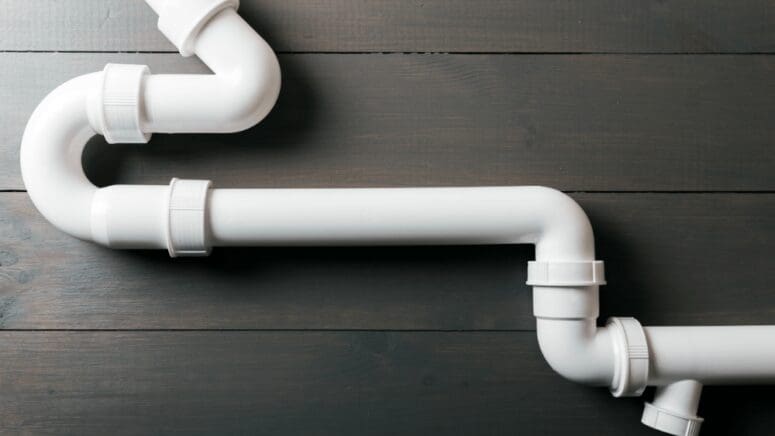One Leaky Pipe Too Many? Here’s the Average Cost to Replumb a House
- Published on
- 8 min read
-
 Kristine Hansen, Contributing AuthorClose
Kristine Hansen, Contributing AuthorClose Kristine Hansen Contributing Author
Kristine Hansen Contributing AuthorKristine Hansen resides in a 1920s Milwaukee bungalow and contributes stories about the real-estate market to outlets that include Realtor.com and HomeLight.com and also covers art, design and architecture for ArchitecturalDigest.com, Invaluable.com and Milwaukee Magazine.
-
 Sam Dadofalza, Associate EditorClose
Sam Dadofalza, Associate EditorClose Sam Dadofalza Associate Editor
Sam Dadofalza Associate EditorSam Dadofalza is an associate editor at HomeLight, where she crafts insightful stories to guide homebuyers and sellers through the intricacies of real estate transactions. She has previously contributed to digital marketing firms and online business publications, honing her skills in creating engaging and informative content.
Old pipes leaking beyond repair? The average cost to replumb a house runs between $371 and $2,133, according to HomeAdvisor.
“It’s pretty expensive to have it done,” says LaNelle McKay, a top real estate agent in Baytown, TX. And unfortunately, you won’t likely recoup the cost of replumbing at resale.
Still, if you have plumbing problems, you need to evaluate if replumbing is necessary. A burst pipe can flood your home and cause significant damage. There are easy steps you can take to evaluate if you need to replumb part or all of your home. To bring you the ultimate replumbing guide, we interviewed two licensed plumbers and two top real estate agents.
Main factors impacting replumbing costs
The total cost to replumb a house varies depending on the materials of the pipes, the size of the home, and the plumber’s hourly rate.
Home size
Just like any major home repair, project cost varies by square footage. Whether you need to replumb a portion of your home or the entire house is also a factor.
The table below summarizes the cost to replumb a house of different sizes.
| Home Size (Square Feet) | Average Cost to Replumb |
| 800 | $3,600 |
| 1,000 | $4,500 |
| 1,200 | $5,400 |
| 1,300 | $5,850 |
| 1,500 | $6,750 |
| 1,600 | $7,200 |
| 2,300 | $10,350 |
| 2,500 | $11,250 |
| 3,000 | $13,500 |
Source: Home Advisor
Pipe material
The cost of pipes varies depending on the material. Many plumbers swear by cross-linked polyethylene plastic (PEX) because it’s flexible, easy to install, and heat resistant. Homeowners like the material because it’s cheaper than copper pipes.
“With PEX, a plumber can typically install within a day. It’s also more freeze-proof than copper. That’s the new standard for homes that are higher-end,” shares Robert Jenkins, a certified plumber in Eugene, OR, and owner of Windmill Valley Properties. “It performs as well if not better than copper in most tests.”
Although copper is the highest-priced piping material, Jenkins shares that it’s still a popular choice in new-builds and higher-end homes, especially when piping is exposed.
According to HomeGuide, the average cost of repiping a home with PEX tubes is $0.40 to $2.00 per linear foot. Meanwhile, installing copper pipe averages at $3 to $8 per linear foot.
According to certified plumber Joe Wood of Boston Standard Company in Mattapan, MA, another popular product with both homeowners and plumbers is ProPress (pressed copper), which comes with a 50-year warranty. Press fittings typically install faster, taking 95% less time than traditional soldering, which can cut down on labor costs.
Labor
The cost of replumbing your house also depends on your plumber’s hourly rate and the amount of time it takes them to complete the job. On average, plumbers charge between $45 and $200 an hour. There’s an additional fee to repair any walls damaged to access the pipes.
Signs you need to replumb your house
To gauge whether or not your house needs new plumbing, hire a plumber to run a scope through your pipes. This check costs between $270 and $1,737 on average. In addition to hiring a pro, look for these tell-tale signs that your plumbing is off:
Home age
First, consider the age of your house. If your house was built before the 1960s and contains its original pipes, you may need to replace them.
“50 to 60 years is the average lifespan for pipes,” notes Wood. “These joints are at a point now where they are dangerous.”
Rusty-colored water coming from your taps
Is your tap water looking brown and cloudy these days? You’ll know when there’s rust in the pipes, based on what comes out of the faucet. A weird smell might accompany an odd hue.
Recurring pipe leaks
To spot pipe leaks, look for pools of water under exterior spigots, in sinks, and within cabinets.
Another way to check for leaks is to shut off the water and see if your water meter changes. If the meter changes right away, your pipes have significant leaks. If it changes within two hours, your pipes have a minor leak. Remember to turn off appliances that run water, such as the laundry machine and dishwasher, before running this test.
Low water pressure
If you notice low water pressure in your bathroom or kitchen, you might want to get your pipes checked.
“A pressure drop should always pique your interest,” says Wood, adding that another red flag is “water hammer,” a rattling sound after the water’s turned off. “That’s a stress on your pipe system,” he says.
You can hire a plumber to conduct a hydrostatic test to detect low water pressure — this test costs between $250 and $500.
Visible signs of corrosion
The most obvious sign of corrosion is calcium build-up on your faucets and drains.
“You absolutely want to fix that before you put the house on the market,” shares top real estate agent Justin Willard, who sells 86% more homes than the average agent in Pembroke Pines, Florida.
“You certainly don’t want calcium chunks on the end of your faucet.”
Iron stains in bathtubs, showers, and sinks are another sign that there’s too much iron in the pipes, which can eventually lead to clogging. You can also check for rust by removing the faucet’s aerator and looking for small chips.
Red flag pipe materials
Plumbing standards have changed over the years, including the type of material used for pipes. If your home was built before the mid-1990s, check your plumbing for these problematic materials.
Lead pipes
Nine times out of ten, lead pipes are original to the structure. If your home was built before 1986, it’s likely that you have lead pipes. It’s important to replace these materials to prevent lead from poisoning your water supply.
Lead can easily slip into your drinking water after a chemical reaction within the plumbing materials, according to the Center for Disease Control and Prevention (CDC).
Polybutylene pipes
Between 1978 and the mid-1990s, contractors often plumbed with inexpensive polybutylene pipes. Over time, builders and homeowners discovered these pipes were prone to leaks, which could significantly damage homes.
“Oftentimes, sellers don’t even know they have it,” says Willard, who hears complaints time and time again about polybutylene pipes’ joints cracking and swelling at the unions.
Today, the International Association of Certified Home Inspectors’ guidelines suggest homeowners replace polybutylene pipes even if there are no signs of damage. In general, home sellers must also disclose polybutylene pipes to buyers when they sell.
“When I work with a seller in a neighborhood that I know has polybutylene, we always have to check before putting the house on the market,” Willard adds. “Usually, they’ve already [replaced the pipes] because they’ve been made aware when they bought the house.”
Galvanized steel pipes
Galvanized pipes are steel pipes dipped in a protective zinc coating that were commonly installed in homes built before 1960. Over decades of exposure, these pipes rust and corrode on the inside, tainting the water supply.
“Galvanized piping is really an old system. If you’re the buyer, you want to change that immediately,” Jenkins comments.
One advantage of galvanized steel is that corrosion is easy to spot. There is usually green sediment, white sediment, or rust on the outside of the pipe.
Cast iron pipes
Willard most often sees cast-iron pipes in homes built during the 1950s and 1960s. Although they were built to last between 80 and 100 years, “over time, they get very brittle [due to] the root systems on trees, especially in South Florida,” he says.
Pipes can influence your home sale
Your plumbing can influence your home sale in several ways. If you find plumbing issues but want to skip the cost to replumb, you must disclose the known problems with your buyer in the Seller Disclosure Form. You can expect your buyer to negotiate a price reduction to reflect the necessary repair in this case.
If you bite the bullet and pay to replumb your house before you sell, remember to mention the new pipes in your home listing and to your buyers.
“If your home is the only one on the block with new plumbing, it’s a big value proposition that needs to be presented to the buyer,” Willard adds.
Header Image Source: (ronstik / Shutterstock)
- "Polybutylene for Inspectors," InterNACHI
- "About Lead in Drinking Water," U.S. Centers for Disease Control and Prevention
- "How Much Does a Sewer Line Camera Inspection Cost in 2025?," HomeAdvisor (December 2024)
- "How Much Does Plumbing Repair Cost? [2025 Data]," Angi (December 2024)
- "How Much Does It Cost to Install or Replace Plumbing?," Homeguide (April 2023)





